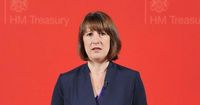The UK faces a significant economic challenge as the government prepares to announce its spring statement next week, a crucial moment that will shed light on the state of public finances and economic forecasts. Rachel Reeves, the Chancellor of the Exchequer, is expected to detail not only her plan for managing a persistent budget deficit but also how the government will address rising public sector borrowing, which surged to its fourth-highest level on record in February 2025. The Office for National Statistics reported public sector borrowing reached £10.71 billion last month, a slight increase from £10.58 billion in the same period last year.
With the government initially forecasting a total borrowing of £127.5 billion for the financial year ending this month, ongoing pressures on revenues have forced revisions. According to ONS data, the current budget deficit amounted to £3.3 billion in February, marking a substantial decline compared to February 2024, which saw a deficit of £4.3 billion. This represents the lowest February deficit since 2022, underscoring the UK's challenging economic conditions.
Reeves’ spring statement is scheduled for Wednesday, March 26, 2025, and is being closely scrutinized as analysts and economists await updates from the Office for Budget Responsibility (OBR). The OBR's outlook, expected to be less optimistic than in previous forecasts, will significantly influence the Chancellor's approach to fiscal policy. The OBR's expected downgrades would complicate Reeves' ability to adhere to her self-imposed fiscal rules and effectively control public spending.
Since taking office, Reeves committed to holding only one major fiscal event annually, with a forecast update reserved for the spring session. However, the window for maneuver appears to be narrowing; she currently has about £10 billion of headroom against her fiscal rules, which is less than the average anticipated OBR revision of £15 billion. Alarmingly, the government borrowed £132.2 billion in the financial year to February, which is £14.7 billion more than at the same point last year, signaling increases in debt that could hamper future fiscal flexibility.
In light of this reality, it is likely that Reeves will announce further measures aimed at cutting public expenditure. The government has confirmed plans for a £5 billion reduction in welfare spending, as outlined in the 'Pathways to Work' green paper. This comes on the heels of warnings from experts about the potentially deeper cuts necessary due to increased inflation and stubbornly low growth.
The upcoming multi-year spending review set for publication in June 2025 is another crucial aspect of the government's fiscal planning, as it will dictate departmental budgets through to 2029. Rumors suggest that regular cuts may deepen, potentially reaching as much as 7% in real terms for several departments over the next few years. This further indicates how constrained the government has become in terms of maintaining public services adequately.
As an indication of the dire nature of the fiscal situation, Reeves is also likely to reaffirm her commitment to increasing defense spending to 2.5% of GDP by 2027. However, this increase may come with significant trade-offs in other budget areas. For instance, the commitment to improve public service efficiency, championed by Prime Minister Keir Starmer, includes possible savings of £45 billion a year from digitization efforts, although the practicality of these savings remains a topic of debate.
The government remains aware of the broader context; while Reeves is determined to cut spending, there is considerable skepticism that such cuts will be sufficient without addressing the underlying causes affecting growth. Economists, including James Smith of ING, caution that while cost-cutting measures may be necessary in the short-term, they emphasize the likelihood of future tax increases should growth not rebound significantly this summer.
The Chancellor's decisions will play a pivotal role in shaping the UK's fiscal landscape amid rising costs of living and a stagnant economy. The outcome of Reeves' spring statement will likely influence household incomes and living standards, which have already been forecasted to grow visibly slower than in the pre-pandemic era.
As the fiscal landscape evolves, public scrutiny will increasingly focus on the government’s ability to reform without falling back into historical patterns of financial mismanagement. The impending announcements will need to prioritize stabilization while avoiding the pitfalls of quick fixes that traditionally characterize past administrations' approaches.
In conclusion, the road ahead is fraught with challenges for the UK government as it tries to navigate a complex economic terrain defined by rising borrowing, stagnant growth, and the ongoing implications of its fiscal policies. How Rachel Reeves manages this delicate balance in her upcoming statement may have lasting effects on the UK economy and public welfare.








